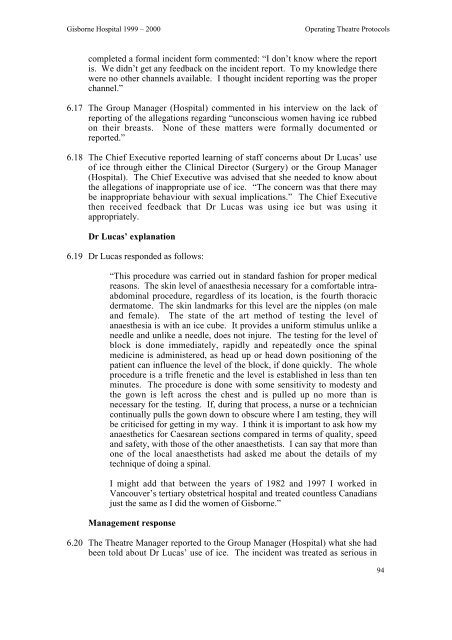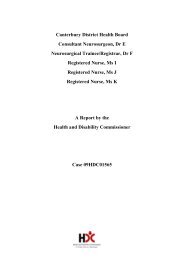Gisborne Hospital Report - Health and Disability Commissioner
Gisborne Hospital Report - Health and Disability Commissioner
Gisborne Hospital Report - Health and Disability Commissioner
Create successful ePaper yourself
Turn your PDF publications into a flip-book with our unique Google optimized e-Paper software.
<strong>Gisborne</strong> <strong>Hospital</strong> 1999 – 2000<br />
Operating Theatre Protocols<br />
completed a formal incident form commented: “I don’t know where the report<br />
is. We didn’t get any feedback on the incident report. To my knowledge there<br />
were no other channels available. I thought incident reporting was the proper<br />
channel.”<br />
6.17 The Group Manager (<strong>Hospital</strong>) commented in his interview on the lack of<br />
reporting of the allegations regarding “unconscious women having ice rubbed<br />
on their breasts. None of these matters were formally documented or<br />
reported.”<br />
6.18 The Chief Executive reported learning of staff concerns about Dr Lucas’ use<br />
of ice through either the Clinical Director (Surgery) or the Group Manager<br />
(<strong>Hospital</strong>). The Chief Executive was advised that she needed to know about<br />
the allegations of inappropriate use of ice. “The concern was that there may<br />
be inappropriate behaviour with sexual implications.” The Chief Executive<br />
then received feedback that Dr Lucas was using ice but was using it<br />
appropriately.<br />
Dr Lucas’ explanation<br />
6.19 Dr Lucas responded as follows:<br />
“This procedure was carried out in st<strong>and</strong>ard fashion for proper medical<br />
reasons. The skin level of anaesthesia necessary for a comfortable intraabdominal<br />
procedure, regardless of its location, is the fourth thoracic<br />
dermatome. The skin l<strong>and</strong>marks for this level are the nipples (on male<br />
<strong>and</strong> female). The state of the art method of testing the level of<br />
anaesthesia is with an ice cube. It provides a uniform stimulus unlike a<br />
needle <strong>and</strong> unlike a needle, does not injure. The testing for the level of<br />
block is done immediately, rapidly <strong>and</strong> repeatedly once the spinal<br />
medicine is administered, as head up or head down positioning of the<br />
patient can influence the level of the block, if done quickly. The whole<br />
procedure is a trifle frenetic <strong>and</strong> the level is established in less than ten<br />
minutes. The procedure is done with some sensitivity to modesty <strong>and</strong><br />
the gown is left across the chest <strong>and</strong> is pulled up no more than is<br />
necessary for the testing. If, during that process, a nurse or a technician<br />
continually pulls the gown down to obscure where I am testing, they will<br />
be criticised for getting in my way. I think it is important to ask how my<br />
anaesthetics for Caesarean sections compared in terms of quality, speed<br />
<strong>and</strong> safety, with those of the other anaesthetists. I can say that more than<br />
one of the local anaesthetists had asked me about the details of my<br />
technique of doing a spinal.<br />
I might add that between the years of 1982 <strong>and</strong> 1997 I worked in<br />
Vancouver’s tertiary obstetrical hospital <strong>and</strong> treated countless Canadians<br />
just the same as I did the women of <strong>Gisborne</strong>.”<br />
Management response<br />
6.20 The Theatre Manager reported to the Group Manager (<strong>Hospital</strong>) what she had<br />
been told about Dr Lucas’ use of ice. The incident was treated as serious in<br />
94
















